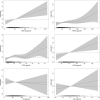Association between ambient air pollutants and preterm birth in Ningbo, China: a time-series study
- PMID: 30236089
- PMCID: PMC6147039
- DOI: 10.1186/s12887-018-1282-9
Association between ambient air pollutants and preterm birth in Ningbo, China: a time-series study
Abstract
Background: Exposure to air pollutants has been related to preterm birth, but little evidence can be available for PM2.5, O3 and CO in China. This study aimed to investigate the short-term effect of exposure to air pollutants on risk preterm birth during 2014-2016 in Ningbo, China.
Methods: We conducted a time-series study to evaluate the associations between daily preterm birth and major air pollutants (including PM2.5, PM10, SO2, NO2, O3 and CO) in Ningbo during 2014-2016. A General Additive Model extend Poisson regression was used to evaluate the relationship between preterm birth and air pollution with adjustment for time-trend, meteorological factors and day of the week (DOW). We also conducted a subgroup analysis by season and age.
Results: In this study, a total of 37,389 birth occurred between 2014 and 2016 from the Electronic Medical Records System of Ningbo Women and Children's Hospital, of which 5428 were verified as preterm birth. The single pollutant model suggested that lag effect of PM2.5, PM10, NO2 reached a peak at day 3 before delivery and day 6 for SO2, and no relationships were observed for O3 and preterm birth. Excess risks (95% confidence intervals) for an increase of IQR of air pollutant concentrations were 4.84 (95% CI: 1.77, 8.00) for PM2.5, 3.56 (95% CI: 0.07, 7.17) for PM10, 3.65 (95% CI: 0.86, 6.51) for SO2, 6.49 (95% CI: 1.86, 11.34) for NO2, - 0.90 (95% CI: -4.76, 3.11) for O3, and 3.36 (95% CI: 0.50, 6.30) for CO. Sensitivity analyses by exclusion of maternal age < 18 or > 35 years did not materially alter our results.
Conclusions: This study indicates that short-term exposure to air pollutants (including PM2.5, PM10, SO2, NO2) are positively associated with risk of preterm birth in Ningbo, China.
Keywords: Air pollution; PM10; PM2.5; Preterm birth; SO2; Time-series analysis.
Conflict of interest statement
Ethical approval and consent to participate
This study did not contain confidential patient data. Committee of ethics, Ningbo Women and Children’s Hospital approved this study. The patient’s consent to participate is not applicable in this study.
Consent for publication
Not applicable.
Competing interests
The authors declare that they have no competing interests.
Publisher’s Note
Springer Nature remains neutral with regard to jurisdictional claims in published maps and institutional affiliations.
Figures


Similar articles
-
Ambient air pollution and preterm birth: A prospective birth cohort study in Wuhan, China.Int J Hyg Environ Health. 2016 Mar;219(2):195-203. doi: 10.1016/j.ijheh.2015.11.003. Epub 2015 Nov 19. Int J Hyg Environ Health. 2016. PMID: 26639560
-
Effects of short-term exposure to air pollution on hospital admissions of young children for acute lower respiratory infections in Ho Chi Minh City, Vietnam.Res Rep Health Eff Inst. 2012 Jun;(169):5-72; discussion 73-83. Res Rep Health Eff Inst. 2012. PMID: 22849236
-
Exploring the association between atmospheric pollutants and preterm birth risk in a river valley city.Front Public Health. 2024 Jul 25;12:1415028. doi: 10.3389/fpubh.2024.1415028. eCollection 2024. Front Public Health. 2024. PMID: 39118970 Free PMC article.
-
Association between exposure to ambient air pollution and hospital admission, incidence, and mortality of stroke: an updated systematic review and meta-analysis of more than 23 million participants.Environ Health Prev Med. 2021 Jan 26;26(1):15. doi: 10.1186/s12199-021-00937-1. Environ Health Prev Med. 2021. PMID: 33499804 Free PMC article.
-
Associations between ambient air pollutants and blood pressure among children and adolescents: A systemic review and meta-analysis.Sci Total Environ. 2021 Sep 1;785:147279. doi: 10.1016/j.scitotenv.2021.147279. Epub 2021 Apr 23. Sci Total Environ. 2021. PMID: 33940406
Cited by
-
Racial disparities in preterm birth in USA: a biosensor of physical and social environmental exposures.Arch Dis Child. 2019 Oct;104(10):931-935. doi: 10.1136/archdischild-2018-316486. Epub 2019 Mar 8. Arch Dis Child. 2019. PMID: 30850379 Free PMC article.
-
Environmental Toxicants and Preterm Birth: A Bibliometric Analysis of Research Trends and Output.Int J Environ Res Public Health. 2022 Feb 22;19(5):2493. doi: 10.3390/ijerph19052493. Int J Environ Res Public Health. 2022. PMID: 35270186 Free PMC article.
-
Short-term effects of air pollution exposure on the risk of preterm birth in Xi'an, China.Ann Med. 2023 Dec;55(1):325-334. doi: 10.1080/07853890.2022.2163282. Ann Med. 2023. PMID: 36598136 Free PMC article.
-
Racial and ethnic disparities in preterm birth: a mediation analysis incorporating mixtures of polybrominated diphenyl ethers.Front Reprod Health. 2024 Jan 8;5:1285444. doi: 10.3389/frph.2023.1285444. eCollection 2023. Front Reprod Health. 2024. PMID: 38260052 Free PMC article.
-
Exposure to ambient air pollutions and its association with adverse birth outcomes: a systematic review and meta-analysis of epidemiological studies.Front Public Health. 2024 Nov 13;12:1488028. doi: 10.3389/fpubh.2024.1488028. eCollection 2024. Front Public Health. 2024. PMID: 39606063 Free PMC article.
References
-
- Blencowe H, Cousens S, Oestergaard MZ, Chou D, Moller AB, Narwal R, Adler A, Vera GC, Rohde S, Say L, et al. National, regional, and worldwide estimates of preterm birth rates in the year 2010 with time trends since 1990 for selected countries: a systematic analysis and implications. LANCET. 2012;379(9832):2162–2172. doi: 10.1016/S0140-6736(12)60820-4. - DOI - PubMed
-
- Polichetti G, Capone D, Grigoropoulos K, Tarantino G, Nunziata A, Gentile A. Effects of ambient air pollution on birth outcomes: an overview. Crit Rev Environ Sci Technol. 2013;43(12):1223–1245. doi: 10.1080/10643389.2011.644214. - DOI
Publication types
MeSH terms
Substances
LinkOut - more resources
Full Text Sources
Other Literature Sources

